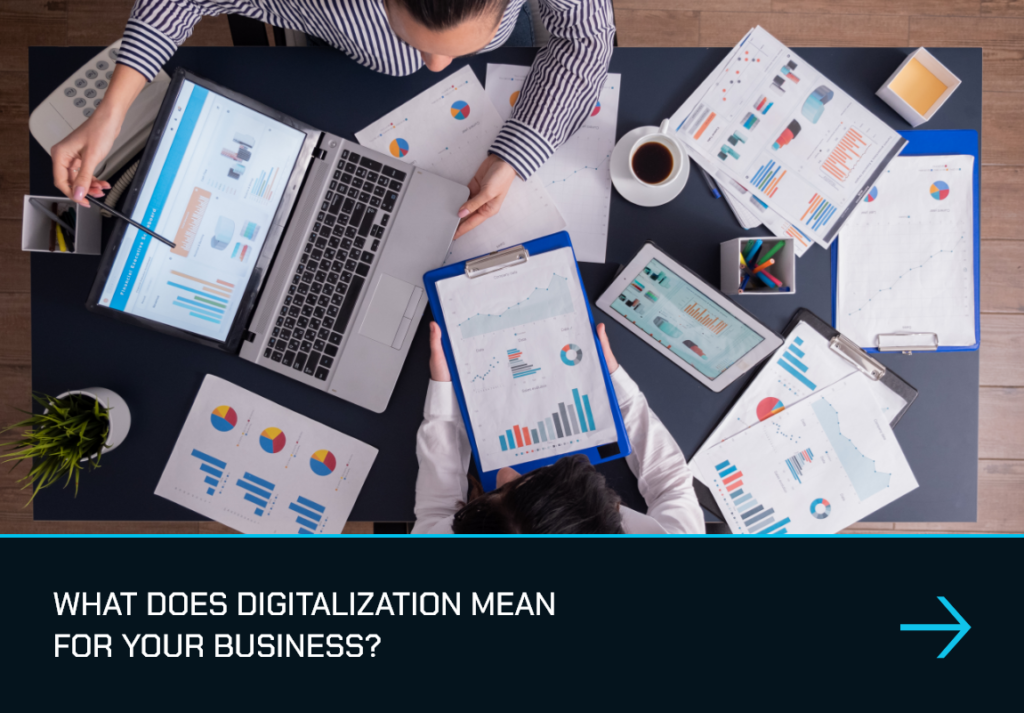The term “digital transformation” is a term that we all seem to use nowadays. It has become a part of our daily routine. However, to realise what it means in businesses, we must take a step back and consider how massive and paradigm-shifting this change is.
The strategic use of digital technologies to generate innovative business models for new market and customer requirements is the simple definition of this concept.
Does it seem like a simplistic proposition?
The truth is, it has completely transformed the way business is conducted. Customers, sales, advertising, and other services are all affected. In terms of planning for and serving clients’ needs, it has entirely revolutionised the way things are done.
Going digital
Converting data from paper to digital format is known as digitisation.
All of a company’s records were once kept on paper: account balances, lever arch files, counter notebooks, faxes, and receipt books, to name a few. Then, companies began to turn this data into a digital version that could be recorded and disseminated using computers.
Initially, computers matched the old-fashioned file system. You looked up the required content in a digital folder or spreadsheet instead of making a paper file. In fact, even the word ‘folder’ is a nod to the days when paper was king. Finding, sharing, and utilising digital information mainly was analogous.
In essence, the term “digitalisation” refers to using digital data to make work easier in ways that would be impossible with paper. Employees can work faster and better with readily available data and not misplaced in a cabinet inside a musty storeroom.
Everyone on the network has immediate access to digital data at any moment.
What is the benefit of this? For example, what if a client wishes to follow up on a transaction? Or an audit requires a technical specification or a piece of transaction information is necessary for tax purposes, what do you do?
Before, the document had to be found and copied before being used. Now, it can be available practically immediately.
As a result, we can manage our company the same way as before, but more efficiently.
However, as digital technology advanced, new opportunities for leveraging business information systems arose. With digital technology, you can achieve something that you couldn’t do with paper.
Transforming business opportunities
The way business is done is changing, and in some cases, totally new sorts of companies are emerging as a result of digital transformation. They are forced to examine what they do and how they do it due to digital transformation.
An example will show you how. Until recently, going to the video rental store was the only method to view a film of your choice in the comfort of your own home. You’d rent a videotape with your favourite movie on it, then watch it on your VCR at home. If you want to return it the day after, you’ll have to rewind it.
With Netflix, we can now view any number of movies whenever we want, on any platform of our choice for a set price. There’s something about this that’s entirely out of the ordinary. Uber and Airbnb are two further examples of digital transformation disruption.
Understanding what technology exists and how it can be leveraged to your business is the first step in implementing and internalising digital transformation. It takes a certain amount of humility to accept that to benefit from digital technology; your company procedures may need to adapt.
The key, though, is to get the buy-in of all stakeholders. The employees, managers, and owners must realize that the changes are all for the better. If they do not fully understand this, your plans will get opposition. People are naturally threatened by changes, unless they know such transitions are for their own good.

Social media
Understanding social media’s immense effect and dynamic impacts on and in your organisation is an integral part of digital transformation. Customer support, promotions, marketing, and sales have all been transformed by this very concept.
Progressive businesses can expand their service offerings by listening to and connecting with their current and prospective customers on their preferred platforms. To improve the customer experience and engage in dialogues, digital networks have to be aware of digital business opportunities.
Today’s customers are technologically savvy and use mobile devices to stay connected to social media at all times. They also want their suppliers to be ready 24 hours a day, seven days a week. The reality is, digital technologies and information advances are driving customer expectations. The customer who is always connected can compare brands and switch from one to another very easily.
Digital change can be especially interesting for small firms. Small businesses don’t have much money to spend on outdated technology and systems. They can now acquire off-the-shelf solutions to fulfil consumer expectations, engage employees, and achieve more with less. As the company expands, the technology systems are also scaled.
Customer experience
Listening to and responding to clients on social media is a fantastic approach. Customer demands may be highlighted, social channels can be integrated into workflows, and brand perception and activity can be tracked throughout social media using several tools and applications.
Thanks to self-service portals, the service shopfront can be available 24 hours a day, seven days a week. Customers can use these portals to change their passwords, log issues, request service, and search for products independently. Chatbots powered by artificial intelligence can respond to simple consumer requests while service professionals focus on more difficult ones.
As a final note, businesses will thrive once they embrace digitalisation. It can be intimidating at first, but learning how to navigate it will be worth it in the end.

